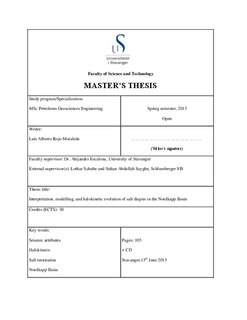| dc.contributor.author | Rojo Moraleda, Luis Alberto | |
| dc.date.accessioned | 2015-09-17T12:04:02Z | |
| dc.date.available | 2015-09-17T12:04:02Z | |
| dc.date.issued | 2015-06-15 | |
| dc.identifier.uri | http://hdl.handle.net/11250/300552 | |
| dc.description | Master's thesis in Petroleum geosciences engineering | nb_NO |
| dc.description.abstract | The Nordkapp Basin provides one of the examples of salt diapirism in the southwestern Barents Sea, becoming an area of interest for hydrocarbon exploration during the last 30 years. Several exploration wells have been drilled close to salt structures, finding hydrocarbons shows but not commercial reservoirs. Consequently, it is of critical importance to get a better understating about salt kinematics, which plays an important role creating structural traps and controlling the distribution of reservoirs around salt structures. In this study, we use 3D seismic data and well data located in the southwestern sub-basin of the Nordkapp Basin. Different mapping attribute workflows are used with the aim of defining salt structures, salt-related structural elements, strata terminations, and halokinetic sequences. Therefore, the main objective is to improve mapping techniques and get a better understanding of salt geometries and movement through time, which can provide insights on basin infill. Preliminary work reveals that the salt was deposited during the Late Carboniferous-Early Permian and was remobilized several times during the Triassic, Late Cretaceous and Cenozoic. Seismic multi-trace attributes like Dip illumination and Variance seem to be very suitable for defining salt bodies. Dip illumination produces and excellent definition of the salt body, and Variance is used to identify locations where the salt flank locations are difficult to define. To identify salt-related structural elements, the attribute Ant tracking is applied on the Chaos volume attribute. The so-called Chaos attribute highlights areas where the seismic shows large variation in the locally estimated dip and azimuth. Ant tracking searches for high energy surfaces (fault planes) provided by attributes such as Variance or Chaos and consequently, is reducing the noise inherited to these volumes attributes. Attributes like Cosine of Phase and frequency filters enhances the continuity of reflectors in areas of uncertainty, and highlights the main strata relationships, being possible to define the periods of salt diapirism and the type of halokinetic sequences. Furthermore, the use of filters and cosine of phase has been crucial in this study to detect the presence of sedimentary wedges. The presence of these wedges indicates a complex salt-controlled sedimentation during the Triassic, ranging from marine to fluvio-deltaic environments of deposition. Uplifted or domed areas caused by diapirism, are interpreted to be the main sources of these wedges, which might act as potential reservoirs within the Nordkapp minibasins. | nb_NO |
| dc.language.iso | eng | nb_NO |
| dc.publisher | University of Stavanger, Norway | nb_NO |
| dc.relation.ispartofseries | Masteroppgave/UIS-TN-IPT/2015; | |
| dc.subject | Nordkapp Basin | nb_NO |
| dc.subject | petroleumsgeologi | nb_NO |
| dc.subject | petroleumsteknologi | nb_NO |
| dc.subject | halokinesis | nb_NO |
| dc.subject | seismic attributes | nb_NO |
| dc.subject | salt restoration | nb_NO |
| dc.title | Intepretation, modelling, and halokinetic evolution of salt diapirs in the Nordkapp Basin | nb_NO |
| dc.type | Master thesis | nb_NO |
| dc.subject.nsi | VDP::Technology: 500::Rock and petroleum disciplines: 510::Geological engineering: 513 | nb_NO |
| dc.subject.nsi | VDP::Mathematics and natural science: 400::Geosciences: 450::Petroleum geology and petroleum geophysics: 464 | |
